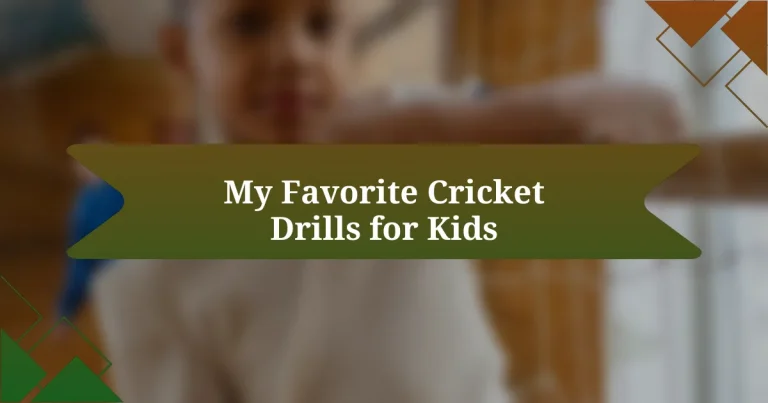Key takeaways:
- Cricket fosters teamwork, discipline, and life skills in children, creating lasting friendships and confidence-building moments.
- Playing cricket enhances physical fitness, hand-eye coordination, and cultivates camaraderie among young players.
- Engaging methods like fun drills and tailored instruction help kids grasp basic and advanced cricket skills in a supportive environment.
- Incorporating feedback and small group activities encourages participation, ownership, and growth in young athletes.
Overview of Cricket for Kids
Cricket is not just a sport; it’s an experience that fosters teamwork and discipline among kids. From my own childhood, I remember how the excitement of hitting that first ball made my heart race. Isn’t it incredible how a simple game can teach kids about cooperation, sportsmanship, and tackling challenges?
As I’ve observed young players during training sessions, their faces light up with joy when they master a new skill or take their first wicket. These moments are more than just milestones; they’re building blocks for confidence that kids carry far beyond the cricket pitch. Have you ever watched a child beam with pride after a successful catch? It’s in these small victories that lifelong memories and friendships are formed.
Engaging children in cricket is about more than just batting and bowling. It’s an opportunity to spark passion, cultivate friendships, and teach important life lessons. I often feel that instilling a love for the game at an early age can leave a lasting impact, shaping not just athletes, but well-rounded individuals. Isn’t that something worth encouraging?
Benefits of Playing Cricket
Playing cricket offers numerous benefits that extend beyond the field. One striking advantage is the development of physical fitness. I remember my early days on the pitch, feeling my muscles strengthen and my endurance improve as I chased after the ball. Doesn’t it feel good to engage in an activity that not only sharpens skills but also promotes health and fitness in kids?
Additionally, cricket is a fantastic way to enhance hand-eye coordination. As kids learn to bowl, bat, and field, they’re honing their reflexes and focus. I recall the thrill of catching a fast-moving ball after countless attempts. It was a moment of triumph that instilled a sense of determination. Isn’t it amazing how a sport can transform persistence into a life skill?
Moreover, the camaraderie built on the cricket field is truly special. I cherish the friendships formed during those team practices, sharing laughter and learning from one another. There was something incredibly bonding about strategizing together and celebrating victories, both big and small. Don’t you think that building such connections through sports lays the groundwork for lasting relationships?
Essential Skills for Young Players
When it comes to cricket, mastering the basic skills is essential for young players. I remember my first attempts at holding the bat properly—at first, it felt awkward, but with practice, it became second nature. Isn’t it fascinating how something as simple as grip can dramatically improve a player’s performance?
Fielding is another critical skill that often gets overlooked. During my early days, chasing down balls and practicing my throws was challenging yet thrilling. There was something incredibly satisfying about nailing a perfect catch or hitting the stumps, which added a spark to my love for the game. Don’t you think the excitement of those moments is what keeps kids eager to learn?
Lastly, understanding the rules of cricket is fundamental. I vividly recall the time when I finally grasped the concept of a “leg bye” after much confusion. It opened a whole new world of strategy for me, making me feel like I was part of something bigger. How rewarding is it to feel confident in the game’s rules, enhancing not just skills but also the love for the sport?
Fun Drills for Beginners
When introducing young players to cricket, I’ve found that using fun drills makes a world of difference. One of my favorites is the “Target Throw,” where kids aim to hit targets set up on a wall or fence. The energy and laughter that come from watching them compete to hit the targets is contagious—how can you not smile while they cheer each other on?
Another engaging drill is the “Balloon Catch.” In this drill, we use balloons instead of cricket balls to help kids practice their catching without the fear of being hurt. I remember the joy on their faces as they scrambled to catch those floating balloons, reminding me that it’s not just about skill but also about having fun and building confidence. Isn’t that a refreshing approach to learning?
Finally, I’ve always enjoyed the “Partner Bowling Challenge,” where kids take turns bowling at targets held by their partner. This drill fosters teamwork and communication, while the competition aspect keeps things lively. Witnessing those initial struggles turning into hearty laughter as they bounce the ball back and forth is truly heartwarming—don’t you think that’s what cricket is all about?
Advanced Techniques for Kids
When it comes to advanced techniques for kids in cricket, I believe it’s crucial to develop their strategic thinking alongside physical skills. One drill I often incorporate is “Shadow Batting,” where kids practice their footwork and shot selection without a ball. Watching them mimic their favorite players while experimenting with different strokes is inspiring; it’s fascinating to see how they start to visualize their movements—do you think adopting these techniques increases their game awareness?
Another technique I’ve found effective is “Wicketkeeping Scenarios.” This involves setting up various in-game situations where kids must react quickly to balls coming from different angles. I remember one young keeper who initially struggled with his reflexes, but over time, he became a wall behind the stumps. It’s rewarding to witness this transformation; you begin to realize that sometimes, it’s about building confidence as much as it is about honing skills, right?
Finally, “Fielding Circuits” are a fantastic way to improve agility and awareness. I usually set up multiple stations where kids practice different types of stops and throws. The excitement in their eyes when they see how their hard work translates into improved performance is palpable. It’s moments like these that remind me of the essence of cricket—it’s not just about the game but the journey of growth and camaraderie.
My Favorite Cricket Drills
One of my all-time favorite drills is the “Cone Challenge.” I like to set up a series of cones in a zigzag pattern for kids to sprint between while fielding. The joy in their faces as they race against their friends reminds me of my own youthful days on the field. Not only does this enhance their speed and agility, but it also cultivates a competitive spirit that can really drive their passion for the game.
I also can’t overlook the value of “Target Throwing.” In this drill, I place targets like bins or hoops at varying distances. Kids take turns throwing the ball to hit the targets. I still recall the first time a shy little girl stepped up to the challenge; her concentration and determination were palpable as she finally knocked the target down on her third try. It’s invaluable to witness how small victories can ignite a flame of confidence in young players. Have you ever seen that spark light up in a child? It’s truly magical.
Lastly, I advocate for the “Batting in Pairs” drill, which fosters teamwork and communication. In this exercise, one child bats while the other stands ready to call for runs. When I first introduced this, it was heartening to see my team develop a rhythm and understanding in their calls. The laughter and excitement as they worked together made me realize that cricket is so much more than just individual skills—it’s about forging connections and enjoying the game together. Don’t you think this sense of camaraderie makes cricket even more enriching?
How to Implement These Drills
When considering how to implement these drills, it’s crucial to create an environment that’s both fun and supportive. I’ve found that starting with a light warm-up helps kids to ease into the activities, making them feel more at ease and excited. Do you remember how intimidating it felt to jump right into a drill without proper preparation? I certainly do, and that’s why I always emphasize the importance of building this foundation.
After warm-ups, I recommend breaking into smaller groups. This not only fosters a sense of camaraderie but also allows for more personalized attention. I vividly recall one session where we grouped kids based on their skill levels. It was rewarding to see their confidence blossom as they practiced at a pace that suited them. How often have you seen a child shine when they’re not overwhelmed? It’s a powerful reminder of how tailored instruction can lead to tremendous growth.
Finally, I suggest incorporating a feedback loop after each drill. Taking a moment to encourage kids or discuss what they enjoyed can reinforce their learning experience. I still cherish the day I asked my team what they thought of the drills; their enthusiastic responses filled me with pride. Isn’t it enlightening to realize that their input not only motivates them but also enriches our practices? Engaging them in this way builds a sense of ownership and eagerness to improve, making every practice session something they look forward to.



